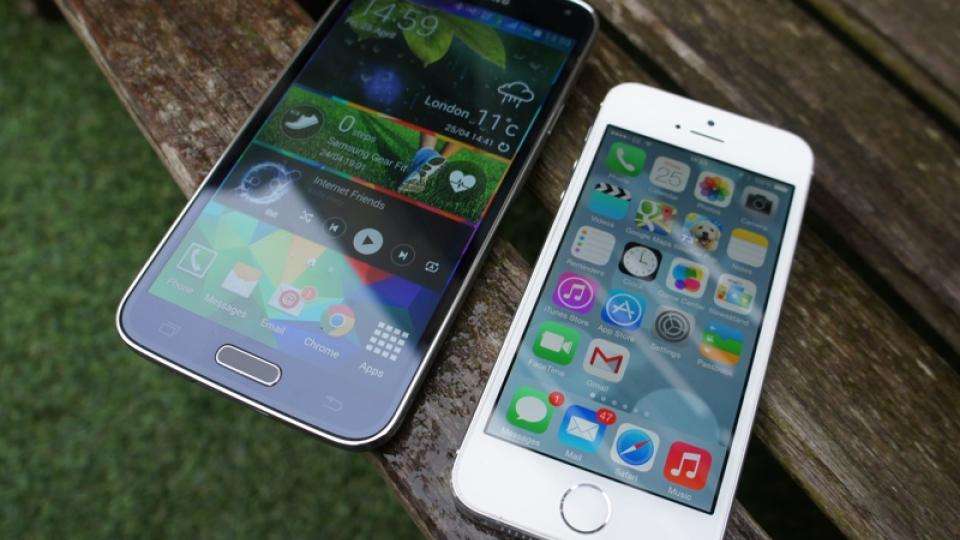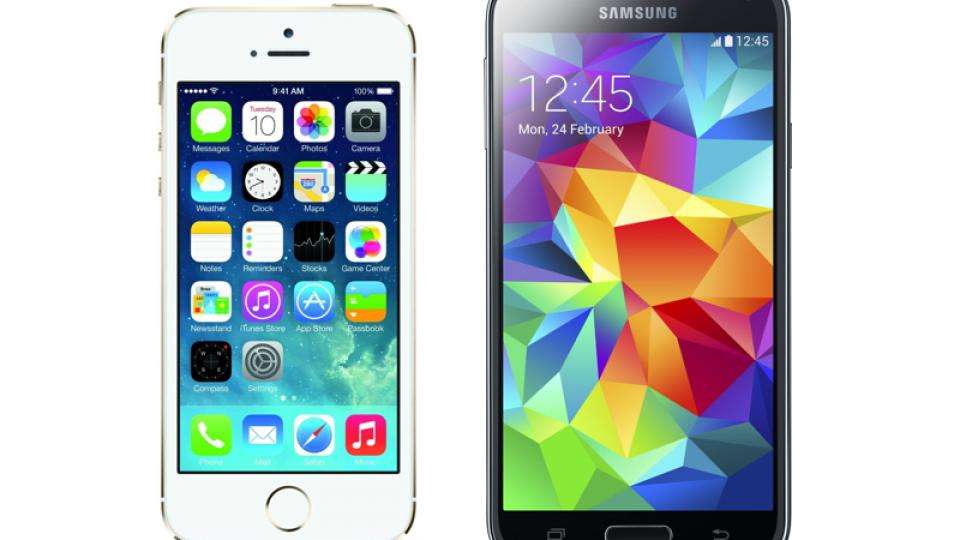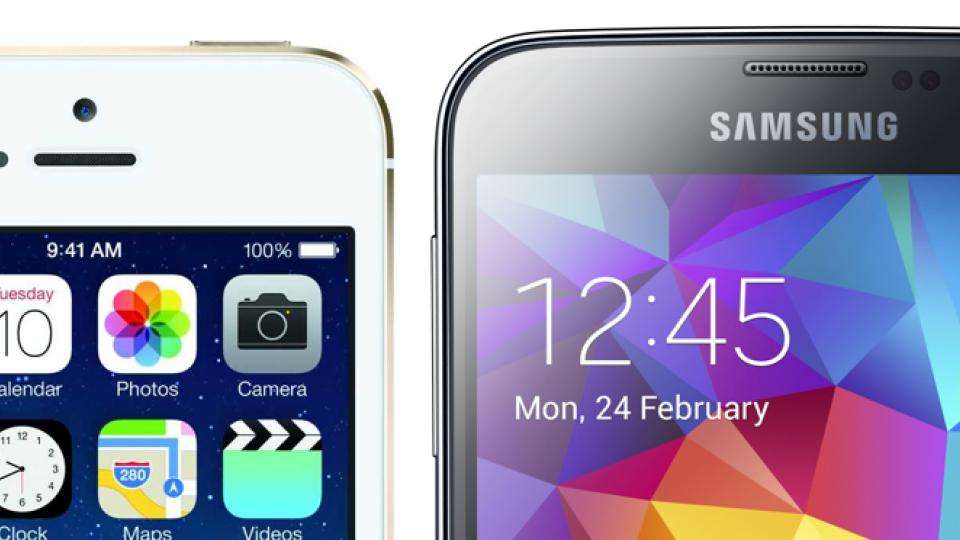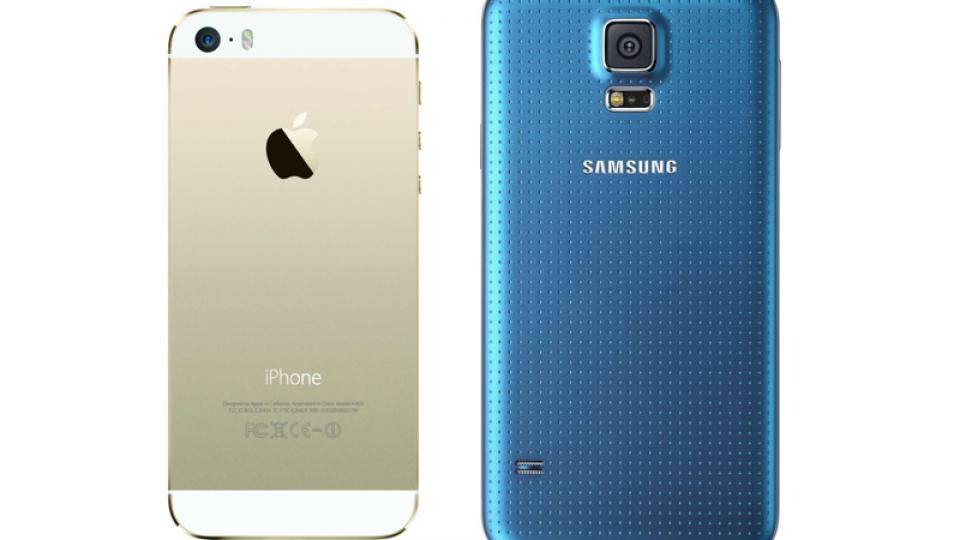Samsung's new flagship smartphone, the Galaxy S5 , is here, and we've been comparing it to the competition to see how it stacks up against the current crop of high-end handsets from other manufacturers. Now it's Apple's turn, as we compare the Galaxy S5 to the venerable iPhone 5s .
Now that we've got both phones in the building, we've gone beyond mere specification comparisons to include benchmark figures, camera comparisons, battery life and detailed display results to deliver a final verdict on which is the better phone. Hopefully this will help you make up your mind on whether to pick up a Galaxy S5, or go for iOS and pick up and iPhone instead.

SIZE AND WEIGHT
Dimensions : The iPhone 5s looks tiny compared to most smartphones. It weighs 112g and measures 123.8 x 58.6 x 7.6mm . The Galaxy S5 is considerably larger and heavier, weighing 145g and measuring 73x142x8.1mm . When held in one hand, you can reach every part of the iPhone's screen, whereas it can be tricky to reach the top left corner with your right thumb, or the right corner when held with the left. However, both still slip comfortably into a pocket - unlike larger phablet phones like Samsung's Galaxy Note 3 .

The iPhone 5s is considerably smaller and lighter than the Galaxy S5
Materials : Apple has always been top when it comes to smartphone design and the iPhone 5s is no different. The iPhone 5s is made from anodised aluminium with diamond cut chamfered edges. It is available in gold, silver and grey. Its full-metal body feels fantastic and it's one of the best-made phones that we've ever seen. It's tough, too; even after almost a year of carrying ours around, our iPhone 5S still looks pristine.
The Galaxy S5 has dimpled soft-touch plastic on the back, which gives it more grip. The plain black finish on the front looks stylish, too, although the silver metal effect trim around the edges remains. Unfortunately the handset is still made from plastic , rather than metal, but is available in more colours: black, white, gold and blue. To be fair to Samsung, it's done a good job of the plastic case and the handset feels well-made and doesn't have the creakiness of cheaper plastic products.
Even so, there's no question that the iPhone feels like a more premium product; despite costing over £550 and looking very sleek, the Galaxy S5 lacks the polish and tough materials that would put it on par with Apple's handset. Hopes that Samsung would address the balanced with a metal Galaxy S5 haven't quite panned out, with the recently announced metal Samsung Galaxy Alpha not quite fitting the bill. While its premium materials look great, the specs have been toned down from the S5's, with a lower-resolution 1,280x720 screen, lower-resolution 12 megapixel camera and slower octa core processor (1.8GHz quad + 1.3GHz quad). We'll have to wait until September to find out if the improved build quality make the Alpha a real contender, although by then we should also have the iPhone 6.
SCREEN
Screen size : The iPhone 5s has a 4in display , which is beginning to look very small when held side-by-side with big-screen Android devices. The 16:9 aspect ratio means it's tall but thin, so your thumb can comfortably reach from the bottom left corner all the way up to the top right. The bezels at either side are a rather slim 4mm thick, meaning 60.6% of the entire front surface is comprised of screen.
The Galaxy S5, meanwhile, has a massive 5.1in screen which makes the iPhone 5s look tiny by comparison. The exterior bezels are slightly thinner too, at 3mm each side. The aspect ratio is also 16:9, but because of the size difference people with smaller hands may struggle to reach the very top of the screen with one hand. There's less room at the top and bottom of the screen for bezels, microphones, speakers or physical buttons, meaning the screen takes up a greater percentage of the front than the iPhone.
Both phones use Corning Gorilla Glass to protect the panel from scratches.

The Galaxy S5 (right) has a much bigger screen and a higher resolution than the iPhone 5s(left)
Resolution : The iPhone 5s has a screen resolution of 1,136x640 - an odd size which is a relic of older iOS devices. That means it is unable to play Full HD video, or even 720p footage at its native resolution, but a 377ppi pixel density means it is still impossible to see individual pixels from an average viewing distance.
The Galaxy S5 has a 1,920x1,080 Full HD resolution display, with a pixel density of 432PPI - despite the larger screen, the pixels are packed in more tightly than on the iPhone. It can play Full HD video at its native resolution, without having to downscale the picture in software. In practice, the larger, wider screen on the Galaxy S5 makes it easier to read websites optimised for the desktop - text can be smaller than on the iPhone yet remain legible.

Screen technology : Apple has always used LCD technology in its iPhones, which is able to produce significantly brighter images than competing technologies. We measured the iPhone 5s' peak brightness at a massive 505cd/m2 , which is almost double that of Samsung's current generation Galaxy S4 - simply put, the iPhone 5s is brighter and produces whiter whites.
Samsung has used AMOLED screen technology in almost all of its flagship smartphones, and the Galaxy S5 is no exception. It has several advantages over LCD technology; individual pixels can be turned off when displaying absolute black images, so AMOLED screens have use less power when displaying them. Contrast ratios are significantly higher than LCD screens too. It has a peak brightness of 339.43cd/m2, much lower than that of the iPhone 5s, but it has a much higher contrast ratio of 26,568:1. Black levels are an incredibly low 0.0128cd/m2, which is practically unbeatable by a conventional LCD display - even one as good as the iPhones.
The Galaxy S5 arranges its sub pixels in a pentile arrangement, interleaving green pixels between alternating red and blue pixels, whereas the iPhone 5s uses three sub-pixels (red, green and blue) for every pixel. This arguably means the iPhone doesn't need as high a resolution to make text and images look as sharp as the Galaxy S5, but in practice we think the Galaxy S5 looks sharper.
In the end, still images look fantastic on both devices. The iPhone produces brighter images overall, with whiter whites, but the Galaxy S5 can produce deeper blacks that make dark images look superior.
PERFORMANCE
Processor : The iPhone 5s has an ARM v8-based 1.3GHz dual-core processor. This translates to an excellent score of 416ms in the SunSpider JavaScript test. The Galaxy S5 has a Snapdragon 801 processor running at 2.5GHz, which translates to speedy benchmark scores. In the SunSpider JavaScript test, the S5 completed the benchmark in 408ms. Considering the architectural and software differences between the two phones, this is a great showing for Android, which has typically struggled to match Apple in the Sunspider test.
Graphics : The iPhone 5s has a PowerVR G6430 GPU. It is one of the best performing phones we’ve ever tested, maxing out both the 3D Mark Ice Storm Standard and Extreme Tests. It scored a very impressive 14,506 in the Ice Storm Unlimited test. The Galaxy S5 has a faster Adreno 330 GPU, which scores 18,438 in the same test. This makes it significantly faster when it comes to games, even when rendering at a higher internal resolution. It will be able to play multi-platform games at higher frame rates than the iPhone 5s in years to come, but right now both are capable of playing anything in their respective app stores.
Memory : Apple has included just 1GB of RAM in the iPhone 5s, but despite the low number that’s still more than adequate due to the way multitasking is handled in iOS. Samsung has bettered Apple by sticking 2GB of RAM into the Galaxy S5, as Android benefits from a larger pool of memory. There's no way to fairly test app loading times cross-platform, but both phones show little sign of lag and open apps quicker than their respective predecessors.
Storage : There are three versions of the iPhone 5s – 16GB, 32GB and 64GB . By comparison the Galaxy S5 only comes in 16GB and 32GB versions, with no 64GB version planned at launch. It does at least have a microSD card slot, which supports up to 128GB cards , but the new file permissions in Android 4.4 KitKat mean you have to use Samsung's My Files app to organise your music, photos and video on the SD card - third party file managers won't work.
Battery : The combination of the new processor, M7 motion processor and 1,560mAh battery all mean that the iPhone 5S has excellent battery life. At half brightness with Wi-Fi turned off, our iPhone 5S lasted 14h 31m in our video playback test. The Galaxy S5 has a significantly larger 2,800mAh battery, although it's powering a faster processor and bigger screen so won't directly translate into a longer lifespan. Even so, it lasted 17 hours 30 minutes in our video rundown test, meaning you can easily go a full day without having to worry about running out of juice.
CAMERA
The iPhone 5s has a 8-megapixel , back side illuminated (BSI) rear camera sensor, which is paired with a dual LED flash . It captures 3264 x 2448 resolution stills and records Full HD video at 30fps , with a slow motion function . The 1/3in sensor has 1.5µm pixels, which are significantly larger than most smartphone cameras to capture more light information.
From the specs, the S5 (right) has more raw pixels than the iPhone 5s (left), but low light performance remains to be seen
The Galaxy S5 has a 1/2.6in sensor with 1.241µm pixels . Despite having a larger 16-megapixel sensor, cramming more pixels into a smaller surface area won't necessarily increase picture quality over the iPhone. The S5's camera also uses the new ISOCELL sensor technology, which reduces the crop factor of the final image and improves dynamic range by preventing light leaking from one pixel to another. It shoots 4,640x3,480 (16.15-megapixel) stills and records 1080p video at 60fps . It is also able to record Ultra HD (4K) 3,840x2,160 video at 30fps and shoot video in high definition .
In our outdoor test shots with high dynamic range (HDR) switched off, both phones capture detailed images with accurate colours, although they struggle to capture detail in the overcast sky and images appear slightly dim or underexposed. Despite the difference in pixels, the iPhone copes very well with landscape shots, with the drop in detail only noticeable once you start zooming and cropping into your images. The pub sign in the bottom corner of the street scene is still legible at full resolution on the Galaxy S5, whereas it is blurred beyond recognition on the iPhone. This detail is even noticeable on closer subjects, like the brickwork on the big building in the foreground.
Switching HDR on makes very little difference on the iPhone in cloudy and overcast conditions; images barely change when toggling the feature on and off, with little extra light information captured by the sensor. Conversely, the Galaxy S5 captures much more dynamic range, creating more lifelike colours, and capturing detail in the sky and light reflections in puddles. The Galaxy S5 also has live view HDR, meaning you can see onscreen what your photos will look like before you press the shutter; with the iPhone you'll have to take a picture then check the gallery to judge the HDR effect.
On paper, the Galaxy S5 has a better front-facing camera - it uses a two megapixel sensor that can record video chat in 1080p at 30fps , compared to the 1.2-megapixel webcam in the iPhone 5s which can only manage 720p FaceTime video at 30fps , although both are really only suitable for video chats so raw resolution isn't a major factor here.
FEATURES
Apple was the first manufacturer to add a fingerprint sensor to a smartphone, fitting a TouchID sensor to the iPhone 5s. It can be used to unlock the phone, or confirm payment when making purchases on the App store, but no other apps support it yet because Apple hasn't made the API public. The Galaxy S5 has its own fingerprint sensor , which is built into the home button. Rather than press and hold, you have to swipe your finger across the button to authorise PayPal transactions, protect files or folders and unlock the handset.
Both take less than a second to unlock, and both struggle to register a print if you have any water on your fingers. You can register more prints on the iPhone than you can on the S5, which is limited to three, although for the best results both phones benefit from scanning one print multiple times for better recognition.
The Galaxy S5 is heavily targeted towards fitness, with ANT+ support for connecting a heart rate monitor or pedometer, and a heart rate sensor built into the back of the phone. It is also water- and dust-resistant . It is also compatible with Samsung's wearable range, including the original Galaxy Gear, new Gear 2 and Gear 2 Neo, and Gear Fit smart band. There are plenty of iPhone apps that do the same job, but all drain the battery faster than using a fitness band.
The Galaxy S5 comes pre-installed with S Health, Samsung's own health hub for collating fitness data, exercise sessions, food and weigh-ins to give users a better idea of their general fitness. Even if you aren't using one of Samsung's wearables, the S5 can use its internal accelerometer to count the number of steps taken per day and use that number to calculate distance travelled or calories burnt, and can also track sleeping patterns based on when you put the phone down at night and when you pick it up in the mornings. The iPhone has no native way of collecting this kind of health information in its current state, although Apple plans to add a fitness-centric Healthkit app with iOS 8 - the next version of its mobile operating system which is all but guaranteed to arrive on the iPhone 5s as a free update later this year.
SMART WATCHES
Although the iPhone can be used with some third-party accessories, such as the Pebble smartwatch, it's fair to say that the Galaxy S5 currently has the lead. As well as working with Samsung's own Gear Fit and Gear 2 , the handset will also work with Android Wear devices. So far we've only seen the rather so-so LG G Watch , but things are starting to heat up with the imminent Moto 360 launch . For Apple we're going to have to wait until the iWatch before we see something truly designed for the iPhone.
Both phones have roughly similar support from other wearable tech , with pretty much every fitness tracker, pedometer and heart rate monitor working with both phones. There are a few exceptions, but our reviews tell you which device works with which mobile operating system.
SOFTWARE
One of the biggest differences between the Galaxy S5 and the iPhone 5s isn't physical - it's in the software. The iPhone runs Apple's iOS operating system, while the Galaxy S5 uses a heavily customised version of Google's Android.
In its first few years, Android had significantly fewer apps than iOS, but now virtually every major brand or developer makes their apps simultaneously for both platforms. There are few, if any platform exclusives any more, and Android has never been easier to use, so if you aren't familiar with either operating system, software is no longer a reason to choose one phone over the other.
There are too many differences between the two operating systems to go into here - for a more detailed breakdown of the features and issues with each one, read our iOS and Android reviews.
4G and Wi-Fi
Both the Galaxy S5 and iPhone 5s support all major 2G, 3G and 4G LTE frequency bands , although the S5 supports the faster LTE Category 4 and LTE-Advanced modes while the iPhone 5s makes do with LTE Category 3. When it first launched the iPhone 5S unable to use O2's 4G network, but this was a certification issue and not a hardware problem - it is now compatible with every 4G network here in the UK, and we expect the S5 to be the same when it arrives.
The iPhone 5s only supports 802.11n Wi-Fi, whereas the Galaxy S5 supports the faster 802.11ac version. Admittedly, this is going to make little difference in day-to-day use. To really reap the benefits of 802.11ac, you need both a very fast internet connection and an 801.11ac wireless router. Even with both, unless you're regularly downloading large files, you'll not really notice the difference between the wireless standards on both phones.
They both support Bluetooth 4.0 and GPS geo-location , but the Galaxy S5 has both NFC and an Infra-red blaster for controlling TVs or other home cinema equipment.
Samsung has moved from standard micro USB to a micro USB3 port on the Galaxy S5, but Apple uses its own proprietary Lightning connector , which connects to USB2. Faster USB is great if you're copying a lot of music, video and pictures to your phone. Both phones use the newer, smaller nano SIM standard, which Apple introduced with the iPhone 5.
VERDICT
The iPhone is a design classic, that has been honed and improved over the years that the iPhone 5s is difficult to criticise if you've only ever used iOS devices. However, anyone coming from an Android device will notice how small it is, even though it admittedly eclipses just about every Android device out there in terms of construction and materials - the Galaxy S5 included. The camera is beginning to show it's age and the Retina screen resolution, once Apple's crowning achievement, has fallen behind Android's 1080p screens.
The Galaxy S5 is incredibly quick, has better battery life, a bigger screen and better camera than the iPhone 5s. It's better connected, too, plus has the added benefit of wearable compatibility with the Gear smartwatch range. Until Apple releases the iWatch Samsung has the lead when it comes to companion accessories.
As for which is best, it still boils down to which operating system you prefer. If you've invested heavily in one OS, buying apps from the store and using specific apps you can't get on other platforms, it will be difficult to switch. Although the iPhone 5s is expected to be replaced by the iPhone 6 later this year, right now it's the best iOS smartphone available, so is still a worthy purchase. However, if you want the latest and greatest, it's undoubtedly the Samsung.
SPECS
|
Manufacturer |
Apple |
Samsung |
|
Model |
iPhone 5S |
Galaxy S5 |
|
HARDWARE |
|
Processor |
Dual-core 1.3GHz Apple A7 |
Quad-core 2.5GHz Qualcomm Snapdragon 801 |
|
RAM |
1GB |
2GB |
|
Screen size |
4in |
5.1in |
|
Screen resolution |
1,136x640 |
1,920x1,080 |
|
Screen type |
IPS |
AMOLED |
|
Front camera |
1.2 megapixels |
2-megapixel |
|
Rear camera |
8 megapixels |
16-megapixel |
|
Flash |
Dual-LED |
LED |
|
GPS |
Yes |
Yes |
|
Compass |
Yes |
Yes |
|
Storage |
16/32/64GB |
16GB |
|
Memory card slot (supplied) |
N/A |
MicroSD |
|
Wi-Fi |
802.11n |
802.11ac |
|
Bluetooth |
Bluetooth 4.0 |
Bluetooth 4.0 |
|
NFC |
No |
Yes |
|
Wireless data |
4G |
4G |
|
Size |
123.8x58.6x7.6mm |
142x72.5x8.1 mm |
|
Weight |
112g |
145g |
|
FEATURES |
|
Operating system |
iOS 7.1 |
Android 4.4 (KitKat) |
|
Battery size |
1,560mAh |
2,800mAh |
|
BUYING INFORMATION |
|
Price SIM-free (inc VAT) |
£549 |
£560 |
|
Details |
www.apple.com |
www.samsung.co.uk |
|
Part code |
Apple iPhone 5S |
SM-G900F |
